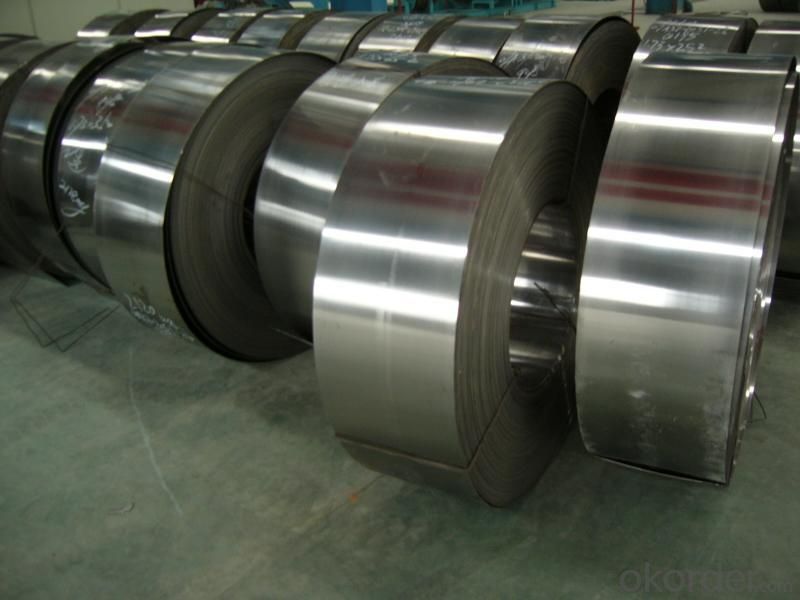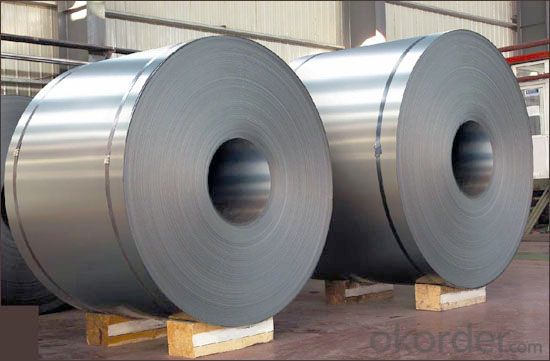Cold Rolled Steel Coil JIS G 3302 -Chinese Best in Low Price
- Loading Port:
- China main port
- Payment Terms:
- TT OR LC
- Min Order Qty:
- 50 m.t.
- Supply Capability:
- 10000 m.t./month
OKorder Service Pledge
OKorder Financial Service
You Might Also Like
Cold Rolled Steel Coil JIS G 3302 -Chinese Best in Low Price
1.Structure of Cold Rolled Steel Description:
The raw material of cold rolled steel coil/sheet is high quality hot rolled product, and after pickling continuous rolling, degreasing, annealing,skin pass,slitting and cut to length line etc. Along with it many kinds of new technology and new process of global cold rolling production have been applied. Therefore the quality of the goods could be guaranteed. The product is widely used in outdoor and interior decoration, furnishing manufacturing, home appliance, automobile etc.
2.Main Features of the Cold Rolled Steel:
• Excellent process capability
• Smooth and flat surface
• Workability, durability
• Excellent heat resistance performance
• High strength
• Good formability
• Good visual effect
3. Cold Rolled Steel Images


4.Cold Rolled Steel Specification
Standard:AISI,ASTM,DIN,GB,JIS,JIS G3302 ASTM 653M EN10142
Grade: Q195~Q345
Thickness: 0.16mm~2.0mm
Width: 1250mm MAX
Coil weight:3-12 MT
Coil ID:508/610mm
Chemical composition:
C | Si | Mn | Cr | Ni | P | S |
0.150 | 0.476 | 11.231 | 12.50 | 0.900 | 0.039 | 0.010
|
5. FAQ of Cold Rolled Steel
1.How to guarantee the quality of the products?
We have established the international advanced quality management system,every link from raw material to final product we have strict quality test;We resolutely put an end to unqualified products flowing into the market. At the same time, we will provide necessary follow-up service assurance.
2. How long can we receive the product after purchase?
Usually within thirty working days after receiving buyer’s advance payment or LC. We will arrange the factory manufacturing as soon as possible. The cargo readiness usually takes 15-25 days, but the shipment will depend on the vessel situation.
- Q:How do steel coils contribute to earthquake resistance in structures?
- Steel coils contribute to earthquake resistance in structures by providing strength and flexibility. When used as reinforcement in concrete structures, steel coils help to distribute and dissipate the energy generated during an earthquake. This helps to prevent the excessive deformation or collapse of the structure, enhancing its overall seismic performance. Steel coils also improve the ductility of the structure, allowing it to withstand the dynamic forces and vibrations caused by seismic activity.
- Q:Can steel coils be coated with abrasion-resistant materials?
- Yes, steel coils can be coated with abrasion-resistant materials. These materials are applied to the surface of the steel coils to enhance their resistance to wear and tear caused by friction, impact, or scratching. The abrasion-resistant coating provides a protective layer that helps prolong the lifespan and durability of the steel coils.
- Q:They are showing on tv a special on how the new World Trade Center, building 1, is being built. Focusing on the steel and the guys fitting everything together.Where do builders go to buy all that steel framing? We do not build really tall buildings where I live so most of the steel is cut and welded on the job site. At World Trade Center 1, they seem to get the steel on trucks; already cut and welded.
- Most of the parts are cut, welded, and fabricated indoors in a welding shop at another location. Then they're trucked to the site and simply need to be bolted together. This is made possible through the use of computer aided design and modeling programs, so that parts can be made to fit almost presciently in the field. They buy the steel from steel companies. I couldn't tell you exactly where it comes from, you'd have to ask the contractors themselves.
- Q:How are steel coils used in the production of steel tanks?
- Steel tanks rely on steel coils as a vital element in their production. These coils, typically made from top-notch steel, act as the primary raw material for manufacturing steel tanks. The initial step involves unrolling and flattening the steel coils, which are usually supplied in a coiled form from the steel mills. Once unrolled, the coils are then cut into specific lengths and widths, depending on the desired dimensions of the steel tank. These cut pieces are molded and shaped into various tank components, including the cylindrical body, top and bottom ends, and additional fittings or accessories. The strength and durability of the tank heavily depend on the steel coils, ensuring its ability to withstand the demands of its intended use. The quality of the steel used in the coils is pivotal as it determines the tank's resistance to corrosion, pressure, and external forces. Additionally, employing steel coils enables efficient and cost-effective manufacturing of steel tanks. The standardized nature of the coils ensures consistent quality and dimensions, streamlining the production process. Precise cutting of the coils also minimizes waste and maximizes material utilization. Furthermore, steel coils offer design flexibility and customization options. They are easily formed and welded into intricate shapes, accommodating tanks of varying sizes, capacities, and configurations. This versatility makes steel coils the ideal choice for producing tanks across diverse sectors, including industrial, commercial, and residential applications. In conclusion, steel coils play a critical role in steel tank production. They provide the necessary raw material for manufacturing different tank components, guaranteeing strength, durability, and customization. By utilizing steel coils, manufacturers can efficiently produce high-quality tanks that meet the specific requirements of various industries.
- Q:I am about to do a welding project and we are instructed to only use mild steel. I want to use found objects like coins, spoons, bottle caps, screws, and other small fasteners. Are these mild steel? What other objects can I use that are mild steel?
- not really. Coins aren't usually made from steel (e.g. an US cent is mainly zinc which will melt with releasing toxic fumes while welding), spoons are usually stainless steel (which is not mild steel), bottle caps can be steel but also aluminum. Fasteners can be made from a wide variety of metals. Generally mild steel is steel with a relatively low content of carbon (2%) which makes it easier to weld. It's used a lot for structure in building (e.g. rebar). Mild steel is also cheaper than other kinds of steel. Tools are usually made from high carbon steel. Generally I'd recommend to go to the scrap yard and pick up some shapes and pieces you like if you don't mind having to clean the rust off. Most will be mild steel. Welding small and thin pieces is much more challenging than welding larger pieces of metal. You are more likely to melt a bottle cap than weld it. Also your steel needs to be clean (no paint, sandblast or brush rust off). I would highly recommend to talk your project over with your teacher before you get all frustrated.
- Q:This is my first time buying new strings for my violin and I’ve narrowed it down to two choice based on reviews and cost. The only difference I can see between the strings is that one has a solid steel core and the other has a synthetic core. What are the pros and cons of each type of core?
- Steel okorder /
- Q:How are steel coils used in the production of electronic devices?
- Steel coils are used in the production of electronic devices for various purposes, such as creating magnetic fields, providing structural support, and acting as conductors in transformers and inductors. These coils are typically wound around a core material, such as ferrite or laminated iron, to enhance their magnetic properties and improve their performance in electronic circuits.
- Q:can u use stainless steel to make a coin? why or why not? answers based on facts plz.
- Stainless steel has been used by some countries to make coins, but it's not an ideal metal. When a coin is struck, a die comes down and strikes the blank with many tons of force (the blank is also sitting on top of another die--one has the image on the obverse (front) of the coin, while the other die has the image of the reverse of the coin). When the die strikes the blank, the force causes the metal in the blank to flow into the recesses of the die. The problem with stainless steel is that it doesn't want to flow into the die. To get an image, either the relief (how high the raised portion of the design will be) has to be very low, and the coin has to have a simple design, or they have to greatly increase the pressure of the strike. This slows the coining press down, and greatly shortens the life of the dies.
- Q:How are steel coils packaged for shipping?
- Steel coils are typically packaged for shipping by being tightly wound and secured with steel bands or straps. They are then placed on wooden pallets or in steel cradles to ensure stability during transportation. Additionally, protective packaging materials such as plastic or cardboard may be used to prevent damage from moisture, dust, or other external factors.
- Q:How long can steel coils be stored?
- Steel coils can be stored for an extended period of time, typically ranging from a few months to several years, depending on various factors such as the type of steel, storage conditions, and protective measures taken.
1. Manufacturer Overview |
|
|---|---|
| Location | |
| Year Established | |
| Annual Output Value | |
| Main Markets | |
| Company Certifications | |
2. Manufacturer Certificates |
|
|---|---|
| a) Certification Name | |
| Range | |
| Reference | |
| Validity Period | |
3. Manufacturer Capability |
|
|---|---|
| a)Trade Capacity | |
| Nearest Port | |
| Export Percentage | |
| No.of Employees in Trade Department | |
| Language Spoken: | |
| b)Factory Information | |
| Factory Size: | |
| No. of Production Lines | |
| Contract Manufacturing | |
| Product Price Range | |
Send your message to us
Cold Rolled Steel Coil JIS G 3302 -Chinese Best in Low Price
- Loading Port:
- China main port
- Payment Terms:
- TT OR LC
- Min Order Qty:
- 50 m.t.
- Supply Capability:
- 10000 m.t./month
OKorder Service Pledge
OKorder Financial Service
Similar products
New products
Hot products
Related keywords





























